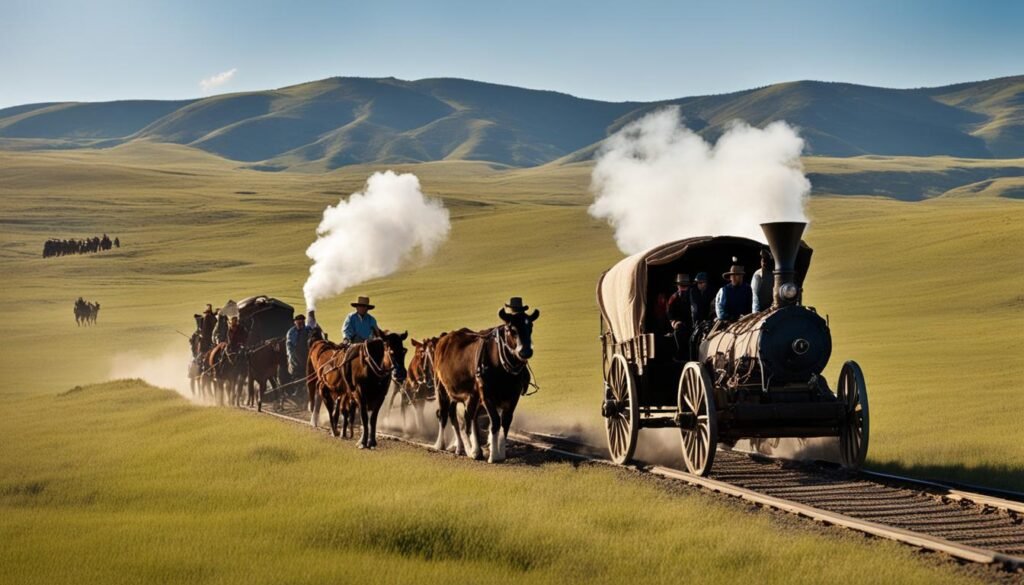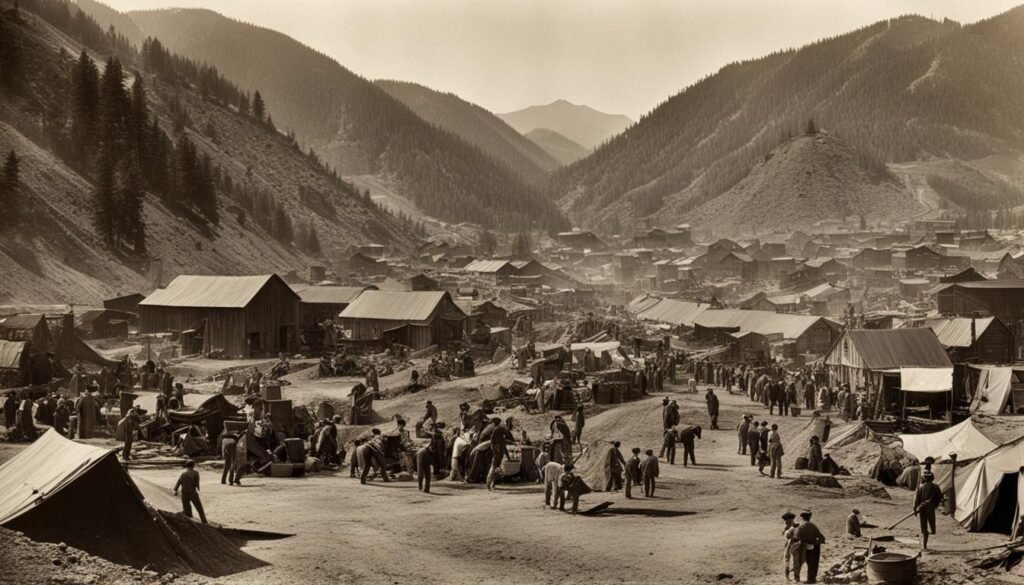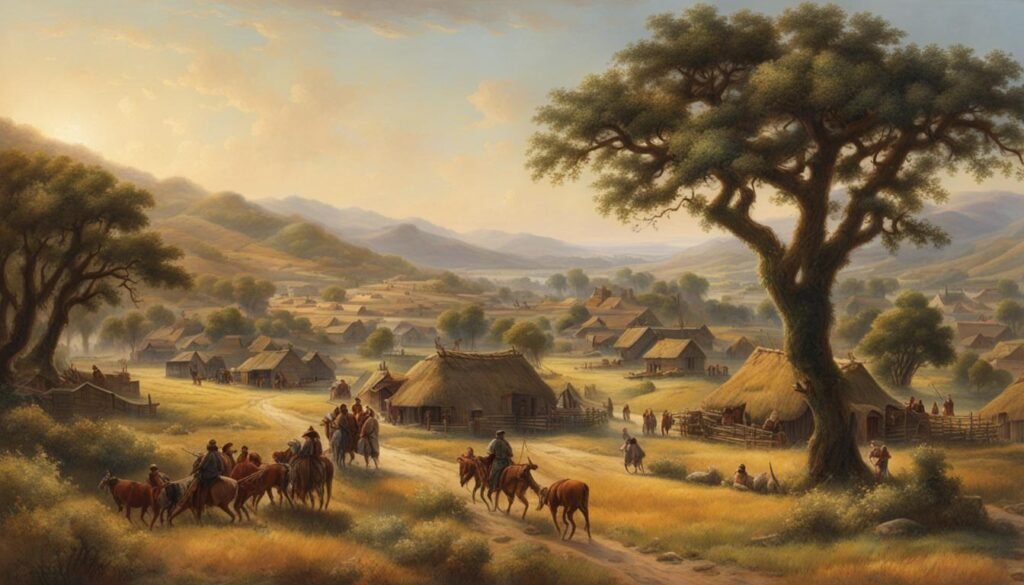The westward expansion of the railroad played a crucial role in shaping America’s frontier and fueling the nation’s growth. Between 1871 and 1900, 170,000 miles of track were added to the existing 45,000 miles. The transcontinental railroads, authorized by the Pacific Railway Act in 1862, connected the eastern states with the Pacific Coast. Four out of five transcontinental railroads received land grants from the federal government, while smaller railroads had to purchase land privately. Railroad construction camps were filled with characters seeking quick profit, and life in these camps was often crude and rough. The railroad system opened up the West, stimulated economic opportunities, and tied the country together.
Key Takeaways:
- The westward expansion of the railroad significantly contributed to America’s growth and development.
- 170,000 miles of track were added between 1871 and 1900, connecting the eastern states with the Pacific Coast.
- Transcontinental railroads played a crucial role in opening up the West and stimulating economic opportunities.
- Land grants from the federal government aided the construction of the transcontinental railroads.
- Life in railroad construction camps was often challenging and rugged.
Construction of the Transcontinental Railroad
The construction of the transcontinental railroad was made possible by the passage of the Pacific Railway Act of 1862. This landmark legislation authorized the creation of a rail connection that would span the entire continent, linking the eastern states with the Pacific Coast. The monumental project involved two main railroad companies: the Central Pacific Railroad and the Union Pacific Railroad.
The Central Pacific Railroad, led by a group of influential businessmen known as the “Big Four” – Leland Stanford, Collis Huntington, Charles Crocker, and Mark Hopkins – undertook the construction starting from Sacramento, California. On the other hand, the Union Pacific Railroad, headed by Dr. Thomas Durant, began building the railway from the Missouri River near the Iowa-Nebraska border.
Both railroad companies were granted extensive land grants and government bonds for each mile of track completed. These incentives helped finance the massive undertaking and encouraged the rapid progress of the construction. However, the path to completing the transcontinental railroad was not without its challenges.
Native American attacks posed a significant threat during the construction process. The railroad crews had to contend with ongoing conflicts and resistance from various tribes as they advanced through their territories. Additionally, the construction teams faced daunting geographical obstacles, such as traversing treacherous mountains and spanning mighty rivers.
The Central Pacific employed a primarily Chinese workforce, comprising thousands of laborers who had migrated to the United States seeking better opportunities. These dedicated individuals endured harsh conditions and performed backbreaking labor to push the railroad forward. On the other hand, the Union Pacific relied heavily on Irish immigrants and Civil War veterans to build its portion of the transcontinental railroad.
Through the combined efforts of these workers, the Central Pacific and Union Pacific steadily made progress, meeting and eventually completing the monumental task of laying the tracks that would unite the nation.
Impact on Westward Expansion
The completion of the transcontinental railroad had a profound impact on westward migration and the expansion of railroads in the American West. Prior to the railroad, traveling to the West Coast was a long and arduous journey, taking months by wagon or stagecoach, or through treacherous sea voyages around Cape Horn or across the Isthmus of Panama. However, the railroad revolutionized transportation and reduced travel time from months to under a week, making it more accessible for Americans to explore and settle the western frontier.
The development of the railroad also played a vital role in the expansion of towns and communities along its route. As the railroads stretched across the vast expanse of the American West, new economic opportunities emerged, attracting businesses, entrepreneurs, and settlers. The railroad became a lifeline for the transportation of goods and people, connecting remote regions with urban centers and facilitating the growth of local economies.
Moreover, the railroad system acted as a catalyst for the overall development of the American West. It fostered the establishment of new industries, such as mining, logging, and agriculture, as resources could be easily transported to markets in the East. The railroads also provided essential means of transportation for the growing population, enhancing mobility and enabling the movement of people seeking better opportunities and a fresh start.

In conclusion, the completion of the transcontinental railroad had a transformative impact on westward expansion. It revolutionized travel, accelerated economic growth, and connected the American West with the rest of the country. The railroad system played a pivotal role in shaping the development and prosperity of the American West, making it an integral part of the nation’s history and identity.
Economic Impact and Commerce
The expansion of the railroad system in the late 19th century had a profound economic impact on the United States. It transformed the railroad industry into a powerful engine of growth and played a vital role in the development of rail networks across the country. The railroad expansion in the West opened up new opportunities for commerce and trade, allowing for the export of valuable western resources to Eastern markets and facilitating international trade.
The transcontinental railroad created a single national market for trade goods, enabling the rapid expansion of American industry and agriculture. With the combination of the transcontinental railroad and the Constitution, the movement of goods and people became seamless, resulting in significant economic growth.
One of the key benefits of the transcontinental railroad was the reduction in travel time and cost. Previously, a coast-to-coast trip took months and was expensive. However, with the railroad, the cost of such a trip was reduced by 85%, making travel more affordable and accessible to a larger population. This accessibility opened up new markets for businesses and allowed Americans to visit distant locations that were previously only heard about.
The railroad system also played a critical role in the expansion of trade and international commerce. It transported freight worth millions of dollars each year, enabling the export of western resources and products to Eastern markets. The efficient transportation provided by the railroad allowed for the growth of industries, spurred economic development, and connected businesses across the country.
Benefits of the expansion of the railroad system:
- Enabled the export of western resources to Eastern markets
- Facilitated international trade
- Created a single national market for trade goods
- Stimulated rapid expansion of American industry and agriculture
- Reduced travel time and cost, making travel more accessible
- Opened up new markets for businesses
- Enhanced trade and commerce on a large scale
Social and Environmental Impact
The construction of the transcontinental railroad had a profound impact on the social and environmental landscape of the United States. As the railroad expanded westward, it shaped where Americans lived and transformed the concept of distances.
Temporary towns sprang up along the route to accommodate the workers, providing vital support and resources during the construction phase. Many of these towns evolved into permanent settlements, contributing to the growth and development of the American frontier.
The Union Pacific, one of the major companies involved in the construction, played a significant role in the establishment of new cities and towns. Approximately 7,000 cities and towns across the country had their origins as depots and water stops along the Union Pacific.
The railroad infrastructure brought people closer together, connecting previously isolated regions and making travel more accessible. The ability to travel quickly and efficiently allowed for greater westward settlement and migration, paving the way for the expansion of the American frontier.
However, this rapid expansion also took a toll on the environment. Thousands of trees were cut down to make way for the railroad, altering the natural landscape. Towns and cities encroached upon once-wild areas, leading to habitat destruction and the displacement of wildlife.
Furthermore, the construction of the transcontinental railroad expedited the hunting of buffalo, which had a significant impact on Native American communities and their traditional way of life. The buffalo, a vital resource for many Native American tribes, faced a rapid decline in numbers due to increased hunting pressure driven by the expansion of the railroad.

The social and environmental impact of the transcontinental railroad cannot be overstated. While it brought progress and opportunity, it also had unintended consequences on the natural world and the lives of indigenous peoples. Understanding the complex legacy of the railroad is essential for appreciating the full picture of America’s westward expansion and the challenges it entailed.
Racial Conflicts and Government Financed Capitalism
The completion of the transcontinental railroad sparked racial tensions in California, particularly between white workers and Chinese immigrants. Blaming Chinese laborers for perceived economic instability, prejudice and fear resulted in the passing of the Chinese Exclusion Act of 1882. This legislation restricted Chinese immigration and prohibited Chinese immigrants from becoming U.S. citizens, exacerbating racial conflicts in the West.
The construction of the railroad also marked a significant development in government-financed capitalism. The Central Pacific’s “Big Four” utilized government assistance to finance the project, putting little of their own capital at risk while the public bore the majority of the financial burden. This model of government-financed capitalism influenced other entrepreneurs and industries, shaping the course of future business practices in the nation.
Conclusion
The construction of the transcontinental railroad played a pivotal role in the westward expansion of the United States, ultimately shaping the nation’s growth and development. By connecting the Western US with the rest of the country, the railroad opened up vast opportunities for economic growth and commerce on a large scale. It allowed for the transportation of goods and resources between the East and West, stimulating trade and spurring the expansion of industries and agriculture.
Moreover, the railroad made travel more affordable and accessible, revolutionizing the way Americans moved across the country. What once took months by wagon or stagecoach could now be accomplished in a matter of days, making it easier for people to explore the western frontier and settle in new communities. The railroad’s impact extended beyond physical transportation, as it created new economic opportunities such as the rise of mail-order catalog businesses, which allowed Americans to access goods and services from distant locations.
However, the construction of the transcontinental railroad also had its negative consequences. The rapid expansion of rail networks and settlements led to the destruction of natural landscapes and the displacement of wildlife. Additionally, the influx of different racial groups, particularly the Chinese immigrants who contributed significantly to the railroad’s construction, resulted in racial tensions and conflicts.
Despite its complexities, the westward expansion railroad remains a significant milestone in American history. It not only transformed the physical and economic landscape of the United States but also set the stage for future endeavors in government-financed capitalism. The importance of railroads in westward expansion cannot be overstated, as they served as the backbone of economic growth and played a crucial role in shaping the nation’s development.
FAQ
How did the westward expansion of the railroad shape America’s growth?
The westward expansion of the railroad played a crucial role in shaping America’s frontier and fueling the nation’s growth. It opened up the West, stimulated economic opportunities, and tied the country together.
What was the Pacific Railway Act of 1862?
The Pacific Railway Act of 1862 authorized the construction of a transcontinental railroad connecting the eastern states with the Pacific Coast. It provided land grants and government bonds for every mile of track built.
Who were the major players in the construction of the transcontinental railroad?
The Central Pacific Railroad, dominated by the “Big Four” businessmen, started from Sacramento, California, while the Union Pacific Railroad, led by Dr. Thomas Durant, started near the Iowa-Nebraska border. The Central Pacific hired Chinese laborers, while the Union Pacific mainly employed Irish immigrants and Civil War veterans.
How did the completion of the transcontinental railroad transform westward migration?
Prior to the railroad, traveling to the West Coast took months by wagon or stagecoach. The railroad reduced travel time to under a week, making it more accessible for Americans to explore the western frontier.
How did the railroad impact commerce and the economy?
The railroad transported freight worth millions of dollars each year, allowing for the export of western resources and facilitating international trade. It created a single national market, rapidly expanding American industry and agriculture.
What were the social and environmental impacts of the railroad?
The construction of the railroad led to the development of temporary towns and permanent settlements along its route. However, it also had a negative impact on the environment, with deforestation and encroachment on wild areas.
How did the transcontinental railroad contribute to racial conflicts?
The completion of the railroad led to increased racial tensions in California, with Chinese immigrants being blamed for economic uncertainties. Prejudice and fear of the Chinese resulted in the passage of the Chinese Exclusion Act of 1882.
What was the impact of government-financed capitalism in the railroad industry?
The construction of the transcontinental railroad pioneered the government-financed capitalism model, with the Central Pacific’s “Big Four” leveraging government assistance. This influenced other entrepreneurs and industries in seeking government help for their businesses.







